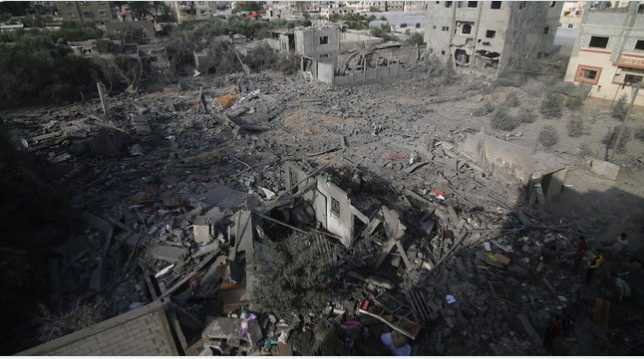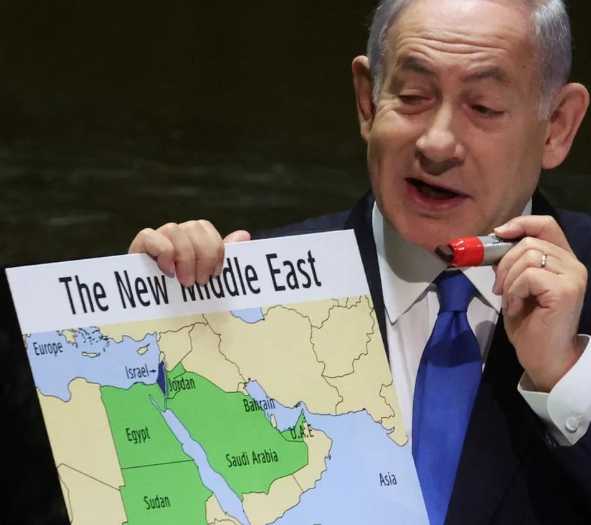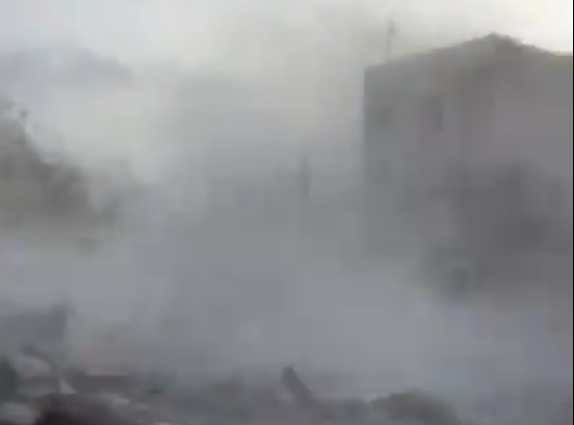“There is no way they could have been considered combatants,” said one writer and analyst. “This is unreal.”
Adding to the mountain of evidence that Israel is engaged in a genocidal war on the Gaza Strip, Al Jazeera on Thursday aired footage of what the news outlet reported was an Israeli drone targeting four Palestinians in Khan Younis last month.
Those killed by the unmanned aerial vehicle in the rubble of the southern Gaza city appear to be unarmed teenagers or young men. According to a translation of the coverage, they were not identified in the reporting.
While Al Jazeera deemed footage “too graphic” to be included on its daily live blog covering the war, a clip of it quickly spread on social media, where critics of the Israel Defense Forces operation expressed outrage.
“OUTRAGEOUS even after months of outrages,” declared Palestinian American political analyst Yousef Munayyer. “This video shows an Israeli military drone literally stalking four unarmed civilians posing no threat and eliminating them one after the other!!!”
Tariq Kenney-Shawa, Al-Shabaka’s U.S. policy fellow, said: “This is among the worst footage I’ve seen. Not only were these boys clearly unarmed and present no threat whatsoever, but they were struck multiple times even after stumbling/crawling away. There is no way they could have been considered combatants. This is unreal.”
Note: The following video contains graphic images.
I don’t know why, but the execution of the final young man, after killed the three he’s with, hits even harder. Absolute depravity. https://t.co/OxRSRL4wH1
— Ryan Grim (@ryangrim) March 21, 2024
Assal Rad, an author with a Ph.D. in Middle East history, said: “Have we ever seen so many war crimes take place right before our eyes? Any country still providing weapons and aid to Israel is complicit in these crimes.”
Exiled American whistleblower Edward Snowden asserted that “everyone in the world needs to see this. Note that this footage permits no room for ‘it was a mistake,’ showing repeated, specifically targeted strikes on the unarmed and even wounded.”
“The sort of behavior the ICJ explicitly forbid in the genocide ruling against Israel,” added Snowden, referencing the International Court of Justice’s preliminary order in January for an ongoing case led by South Africa.
Since the ruling, rights groups around the world have accused Israel of ignoring the ICJ order by continuing to bomb and starve people across Gaza. The mounting casualties—at least 31,988 killed and 74,188 wounded—have elevated demands for the U.S. government to end arms transfers to Israel.
The United States gives its Middle East ally $3.8 billion in annual military aid and since the Israeli assault was launched in retaliation for a Hamas-led attack on October 7, the Biden administration has sought $14.3 billion more while bypassing Congress to send more weapons. U.S. President Joe Biden, Secretary of State Antony Blinken, and Secretary of Defense Lloyd Austin face a genocide complicity case in federal court.
While the Biden administration has repeatedly vetoed and opposed cease-fire resolutions at the United Nations Security Council and General Assembly, Nate Evans, a spokesperson for Linda Thomas-Greenfield, the U.S. ambassador to the U.N., confirmed Thursday that the United States plans to unveil a new one on Friday.
The resolution will “unequivocally support ongoing diplomatic efforts aimed at securing an immediate cease-fire in Gaza as part of a hostage deal, which would get hostages released and help enable a surge in humanitarian aid,” Evans told Al Jazeera. “This resolution is an opportunity for the council to speak with one voice to support the diplomacy happening on the ground and pressure Hamas to accept the deal on the table.”
Blinken said Thursday that “there’s a clear consensus around a number of shared priorities. First, the need for an immediate, sustained cease-fire, with the release of hostages. That would create space to surge more humanitarian assistance, to relieve the suffering of many people, and to build something more enduring.”
Common Dream’s work is licensed under a Creative Commons Attribution-Share Alike 3.0 License. Feel free to republish and share widely.
[content id=”79272″]







